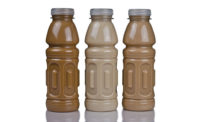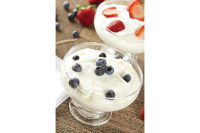Moviegoers don’t flock to the latest installment of their favorite superhero franchise for deep musings on the human condition. By that same token, consumers don’t dive into salted-toffee truffle sundaes to jumpstart their diets. They do it because it’s fun.
But in this label-reading age, even the fun stuff gets scrutinized. So considering that nothing is more fun than the chips, chunks and salted-toffee truffles that find their way into ice cream and yogurt, it’s only natural that the clean label trend has come to the previously carefree category of inclusions and variegates.
To some extent, the scrutiny is nothing new. As early as 2015, Unilever U.S., Englewood Cliffs, N.J., pledged to transition its entire portfolio of ice cream brands (including Good Humor, Klondike and Magnum novelties) away from milk and cream sourced from cows treated with artificial growth hormones. In making that pledge, the company conceded that a parallel transition to scrub inclusions of “chemicals,” allergens and other rogue ingredients would be a heavier lift.
At long last, that lift may be lightening, for inclusion suppliers have been adjusting formulations. They now offer dairy developers options that work well in applications and look appealing on a label. We quizzed these experts on how today’s inclusions bridge the gap between carefree and “free-from.”
Dairy Foods: Prognosticators are betting that “clean labels” will drive R&D in 2017. Does that jibe with the requests you’re getting from your customers?
Rick Stunek: Definitely. As with most of our other R&D projects, clean labeling for inclusions is among the most common requests.
Kevin W. Holland: Absolutely. Most of our projects have stipulations around allowable ingredients, and it’s easy to see what’s driving those demands.
Dairy Foods: What’s driving them?
Tom Payne: The obsession, so to speak, with clean labels may, like so much else these days, have something to do with millennials and their impact on so many facets of our culture. The $96 billion they spend on food each year has affected the industry in many ways, from restaurant menus, packaging design, ingredient research and new product development to advertising and marketing.
Dairy Foods: Just what sort of transparency are millennials and other clean-label enthusiasts seeking?
John Pimpo: Most new ideation we’re doing calls for clean-deck ingredients. And those requests vary between standard definitions of clean deck — no artificial colors, no artificial flavors, no partially hydrogenated oils, et cetera — to non-GMO, RSPO [Roundtable on Sustainable Palm Oil] and organic. There’s a larger variety of clean-deck requests than just clean label.
David Shen: There are different “grades” of clean label. Requests range from something as simple as “natural flavors and colors” to complex multilevel “non-GMO, no preservatives, kitchen-friendly, limited-number-of-ingredients.”
Dairy Foods: Let’s explore that further. What are the hallmarks of a clean-label inclusion?
Stunek: Fortunately or unfortunately, my view doesn’t count. It’s the consumer who drives this. That said, it’s currently about the removal of artificial ingredients and those that don’t have appealingly simple names.
Shen: “Minimally processed” was a marketing term that could’ve satisfied consumers in the past. But now, with so much focus on clean, consumers are more educated and look for claims on packaging such as non-GMO, as well as natural, no hormones and organic. They’re increasingly drawn to words such as clean, simple, locally sourced and artisan.
Dairy Foods: That gives developers a lot of room to maneuver — perhaps too much. In light of the ambiguity, do you think it might be easier to characterize an “unclean” inclusion than a clean one?
Stunek: Two thoughts: One, if a consumer doesn’t know what something on the ingredient deck is, they’ll almost certainly interpret it as “dirty” regardless of what it actually is. And two, if an Internet blogger’s created hysteria about a particular ingredient in an inclusion, that doesn’t help either.
Tom Jablonowski: Since there’s no legal definition of “clean label,” suppliers rely on the dairy developer to provide that clarity. Depending on our customer’s definition of “clean,” we’re often asked to avoid a long and lengthy number of ingredients in the label declaration, and ingredients that are “chemical” sounding or difficult to pronounce. If the product will be labeled “natural,” then artificial flavors and colors are definitely avoided.
Holland: For fruit products, there was a time when sulfites and high-fructose corn syrup were accepted in most products. But those tables have turned and now customers are looking for sulfite alternatives and other sweetener systems. It’s been interesting to see how ingredients that were considered too expensive are now used because of market demand.
Dairy Foods: You raise an important point — namely, that formulating clean inclusions can involve tradeoffs, in terms of cost, functionality or otherwise. Let’s step back and inventory the benefits that earned “unclean” ingredients a spot in inclusions formulations in the first place.
Shen: Preservatives such as ascorbic acid, citric acid, propylene glycol, sodium benzoate and potassium sorbate help prevent spoilage from bacteria, molds, or yeast. They can also function as antioxidants, slowing or preventing changes in color, flavor or texture and delaying rancidity.
Sweeteners such as xylitol, sorbitol, mannitol, corn syrup, high-fructose corn syrup, saccharin, aspartame and sucralose may not be considered clean, but they can add greater sweetness than regular sugar at a lower use level. These sweeteners also have the benefit of lower calories per serving than regular sugar.
Color additives such as FD&C Blue 1 and 2, FD&C Green 3, FD&C Red 3 and 40 and FD&C Yellow 5 and 6 are more stable and are less likely to suffer color loss from exposure to light, air, temperature extremes, moisture and storage conditions. Color additives can also help to correct natural variations in color and enhance natural colors.
Dairy Foods: What happens when a dairy processor replaces these ingredients with cleaner options?
Shen: Color and flavor stabilities are probably the most common issues we face as we formulate a cleaner product. Natural colors and flavors are typically derived from fruits and vegetables and are more sensitive to environmental factors such as temperature, light and product pH. Natural colors fade over time, too, limiting product shelf-life quality. Natural flavors can suffer the same effects, degrading faster over shelf life. All of these factors have to be considered during formulation to achieve the proper flavor and appearance throughout the span of the product shelf life.
Dairy Foods: Are such tradeoffs inevitable in clean-inclusion formulation?
Stunek: It’s often hard to find clean alternatives that exactly replicate a particular taste or functionality. The key is to test things. Never assume you know all the consequences of a formulation change.
Holland: Sometimes there is no tradeoff, which is always the goal. But when there are, the value is determined by the consumer. As long as people who want to avoid certain ingredients are willing to pay more or eat foods that aren’t as brightly colored, for example, the tradeoffs are worth it.
Shen: Unfortunately, I think there do need to be some tradeoffs. But consumer demand continues to drive innovation.
Dairy Foods: Describe some of these innovations.
Shen: Specialty ingredient suppliers have created natural bioproducts that can offer a range of natural food protective solutions. These bioproducts have cleaner ingredient names and can help reduce food safety risks, protect shelf life and maintain the organoleptic qualities of food, all while meeting consumers’ demand for natural products.
Dairy Foods: That does sound innovative. But is clean formulation all about innovation? Are some inclusion suppliers going back to basics to go clean?
Shen: Controlling finished-product water activity is one way we can navigate around not being able to use typical preservatives. Limiting the amount of water in the product also helps control color degradation.
And we’ve started looking at using real fruits to supplement natural flavors in formulations. These fruits are pureed, freeze-dried or dehydrated. Combining different formats has allowed us to add a little more stability to address flavor and color concerns over shelf life. These fruit additions also help create a more visually appealing product.
Dairy Foods: Let’s talk more about fruit. It seems to fit what a consumer would want in a clean inclusion, right?
Payne: According to trend watchers, blueberries are a favorite of millennials. The blueberry image is used to imbue products with a virtuous and planet-friendly aura — another virtue of importance to millennials.
Dairy Foods: What about clean chocolate?
Jablonowski: In many cases, it’s just a matter of going back to the basic ingredients. For example, semisweet chocolate has a standard of identity in the U.S. Code of Federal Regulations. That standard spells out exactly what can be used as an ingredient when making and labeling semisweet chocolate. The chocolate food scientist, with input from the customer, uses that listing in the CFR to construct a product with “clean” connotations that can still be called semisweet chocolate.
Dairy Foods: So that’s fruit, chocolate. What about nuts?
Smith: When manufacturers choose almonds for their dairy products, they’re usually looking to add a clean option that’s known for flavor, texture, crunch and nutrition. In fact, we’ve seen increased use of almonds that carry a flavor — both sweet and savory. We’re working with manufacturers to include almonds with flavors such as orange, honey and coconut. We also have new savory-salty flavors that could be a delicious contrast to the sweet creaminess of ice cream, for example.
We’re seeing the use of almonds expand in the yogurt category, too, particularly in Greek yogurts. Almonds add a “crunch factor.” That’s definitely a hot button. This has been a driver in many new product formulations: getting that crunch into something like a granola blend-in that the consumer adds. And with the abundant almond forms available, from whole, sliced and diced to slivered, flour and meal, there’s no doubt that almonds as inclusions balance functionality with label friendliness.
Meet the panelists
Dairy Foods invited suppliers of nuts and inclusions to participate in this virtual roundtable. The moderator was Ingredients Editor Kimberly J. Decker.
- Kevin W. Holland, product developer, Tree Top, Selah, Wash.
- Tom Jablonowski, senior technical services manager, Cargill Cocoa and Chocolate, Minneapolis
- Tom Payne, industry specialist, U.S. Highbush Blueberry Council, San Mateo, Calif.
- John Pimpo, sales manager, east, ingredients and contract manufacturing division, Gertrude Hawk Chocolates, Dunmore, Penn.
- David Shen, director of operations and R&D, Parker Products, Fort Worth, Texas
- Jeff Smith, director of marketing, Blue Diamond Almonds Global Ingredients Division, Sacramento, Calif.
- Rick Stunek, marketing and sales, Forbes Chocolate, Broadview Heights, Ohio





